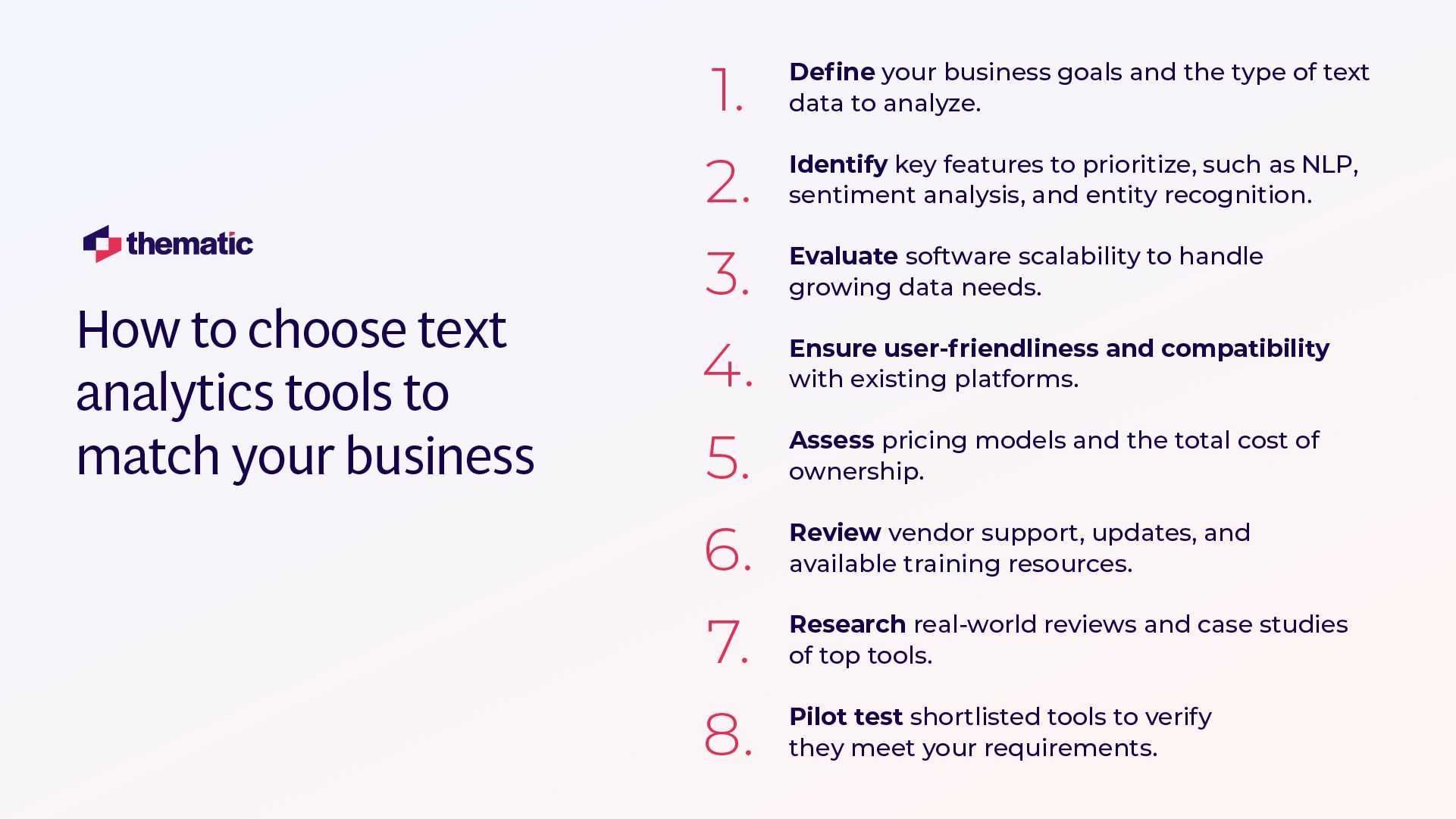
Learn how to choose the right text analytics tool with this guide, covering features, scalability, and business needs.

In 2023, the global text analytics market was valued at $15.54 billion, with projections to grow to $52.21 billion by 2030. Why? Because businesses are producing massive volumes of text data—from customer reviews and social media to emails and surveys.
So, how can you make sense of all this data? Text analytics is the key.
You’re probably here because you already know your business can benefit from text analytics but are overwhelmed about how to choose text analytics tools to match your business.
Don’t worry—you’re in the right place. We’re here to guide you in finding the perfect text analytics tool for your business.
Let’s start!

Before diving into how to choose text analytics tools, it’s best practice for any business to start by defining clear goals. Without a clear direction, you risk wasting time, effort, and money on scattered efforts that lead nowhere.
Think about it: Do you want to improve customer satisfaction? Enhance your products? Or maybe you’re trying to pinpoint pain points in your unstructured text data, like social media comments or survey responses. Knowing your goals helps you identify the data sources to analyze and prioritize the right insights.
Your business goals are your destination. Every decision you make, including the tools you invest in, should build towards achieving your goals.
Here are some tips for defining goals:
Start with Specific Questions
Ask yourself what you want to achieve with text analytics. Are you looking to uncover insights to improve your voice of customers for product operations? Do you want to understand trends in customer sentiment? Be specific—vague goals lead to vague results. For example:
Identify Your Data Sources
Knowing what type of data sources you’ll analyze helps you prepare for the unique challenges of working with different formats. Ask:
Understanding your sources enables you to choose tools capable of handling them efficiently.
Align Goals with Business Outcomes
Tie your objectives to specific business results to ensure your efforts pay off. For instance:
Bonus Tip: Prioritize Feasibility
Focus on goals that you can realistically achieve with the resources and data you have available. It’s better to start small and expand once you see measurable results.
Let’s talk about what makes a great text analytics tool.
At its core, these tools are powered by artificial intelligence (AI)—things like natural language processing (NLP), machine learning models or techniques, large language models, and generative AI. Basically, these technologies understand text, learn from patterns, and even predict trends, making qualitative data analysis a breeze.
But AI text analytics is just the foundation—there’s more to look for when choosing the right tool.
Key Features to Look For
Here are some text analytics features worth looking into:
Imagine this: your business starts small, analyzing a few dozen customer reviews each week. Fast forward a year, and now you’re handling thousands of comments from social media, surveys, and emails. Can your tool keep up? Scalability is crucial. A good text analytics tool should handle vast amounts of unstructured text without breaking a sweat. As your data grows, the tool should grow with you, maintaining its speed and accuracy.
Now, let’s talk about integration. Your text analytics tool shouldn’t exist in a vacuum—it needs to work seamlessly with the other systems you rely on. Whether it’s pulling customer feedback from a CRM or pushing insights to an analytics dashboard, compatibility with analytics platforms is key. This ensures all your tools are working together, saving you time and effort.
What Should It Integrate With?
One of challenges with text analytics tools if intergrating with the right tool. Thematic integrations cover all these bases, ensuring a smooth flow of data between your tools.
Let’s face it—budget matters when choosing text analytics software, but the cheapest option isn’t always the smartest. Instead of focusing solely on the price, think about long-term value. A slightly more expensive tool might save you hours of work or give you insights that boost customer satisfaction, making it well worth the investment.
Start by comparing pricing models. Some tools charge based on the number of users, while others are pay-as-you-go or subscription-based. Pick a model that fits your needs now but can also grow with your business.
Don’t forget to take advantage of free trials or demos. These allow you to test the software’s features and see how it fits your workflow. A trial period gives you hands-on experience and helps you avoid buyer’s remorse. You’ll quickly know if a tool’s interface is user-friendly and if it has the capabilities you need.
Equally important is vendor support. Even the best text analysis tools can feel daunting without proper guidance. Look for companies that provide:
Your thematic analysis software should have excellent support. Remember, you’re not just buying software—you’re gaining a partner in success.
When considering how to choose text analytics tools, don’t just rely on feature lists or marketing promises. A vendor’s case studies are one of the best ways to see if a tool delivers results in real-world scenarios. These examples showcase how businesses, just like yours, have successfully used the tool to solve challenges and achieve their goals.
Start by visiting the vendor’s website and exploring their case studies. Look for examples in industries relevant to yours, like customer service or customer experience management. Why? Because these use cases reveal how the tool performs under real conditions and whether it can handle challenges similar to yours.
Tips for Evaluating Case Studies
Now that you’ve narrowed down your options, it’s time to take the next step—pilot testing. This is your chance to see how the tool performs with your real-world data sets. Think of it as a test drive before committing, giving you valuable insights into whether it’s the right fit for your business.
How to Conduct a Trial
You can text Thematic with a guided trial on your own data to assess all the key points we’ve discussed here. Try Thematic now!
Tips for Testing Tools
Text analytics matters, but without the right tool, it could be futile.
The final step? Deciding the tool that will be your long-term partner. How do you know? It’s the one that best aligns with your business goals, offers the most value, and fits your budget—or comes close enough to justify a small compromise. Remember, the perfect tool may not tick every box, especially if your budget is tight, but the right choice will balance your priorities and deliver the results that matter most.
Let’s review.
When choosing a text analytics tool, start with defining your goals, exploring essential features, and evaluating scalability and integrations. Think about what specific problems you’re trying to solve and how the tool’s features can support those objectives. Of course, look at real-world case studies to see the tool’s impact—these can show you how businesses like yours have benefited.
And don’t skip the pilot testing phase; testing the tool with your own data sets will give you firsthand insight into its usability, accuracy, and whether it can handle the nuances of your data effectively.Want to see how text analytics can handle your own data? Get a demo of Thematic to experience text analytics in action using your data.
Join the newsletter to receive the latest updates in your inbox.